How to Understand Genesis 5 Ages 4 Script is from the fourth video
in the series, based upon works at the timeemits.com website. Videos
and scripts are available resource sets. Ages of Adam determines
actual ages and numbers as written in Genesis 5. Holy of Holies is
an ongoing project which includes later Antediluvian Patriarchs and
related calendar articles.
HTU_Gn_5_Ages_4_Script.html 15:22
Understand Genesis 5 Ages 4 Video
Series: Jesus & Solar Time Stream
Ages of Adam Timeemts.com Intro.mpg 15 secs
Gn_5_Ages_4pic90pcb.jpg Chroma
key inset from raw footage take4a.mpg overlay 1:45
LS_4x2rr1SSa_1 from 3 adjust
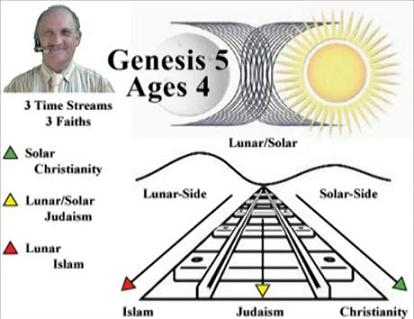 How to
Understand Genesis 5 Ages number 4 fast forwards from
ancient Genesis 5 Ages of Adam and Seth to introduce
spiritual concepts associated with calendar science. The emergence
of three time streams: lunar, lunar/solar and solar from
very early recording touches elements of Chaos that still exist. Holy
Bible time becomes organized through the Creative Week,
immediately followed by lengthy Genesis 5 Ages of the
Patriarchs. God is spirit, and His manifest powers
align with spiritual priority. Hidden influences, long thought
dormant, might awaken with candid resilience after many thousands
of years. This video examines the most important calendar gap in
history and how the Son of God appears as intercessor for
Christians.
How to
Understand Genesis 5 Ages number 4 fast forwards from
ancient Genesis 5 Ages of Adam and Seth to introduce
spiritual concepts associated with calendar science. The emergence
of three time streams: lunar, lunar/solar and solar from
very early recording touches elements of Chaos that still exist. Holy
Bible time becomes organized through the Creative Week,
immediately followed by lengthy Genesis 5 Ages of the
Patriarchs. God is spirit, and His manifest powers
align with spiritual priority. Hidden influences, long thought
dormant, might awaken with candid resilience after many thousands
of years. This video examines the most important calendar gap in
history and how the Son of God appears as intercessor for
Christians.
Genuine acts of God
delivered via magical channels portray miraculous results. Roman
BCE events significantly impacted the solar calendar time
stream. A calendar gap occurred when Rome switched from a
multitude of lunar and lunar/solar calendars to establish the Julian
solar calendar. Heavenly forces were activated to set the
stage for Jesus Christ. Divine intervention occurs to bridge the solar
calendar gap.
Gn_5_Ages_4pic2pc85b.jpg
Chroma keyed inset from raw footage take4ab.mpg 2:04
Angels & Demons_1.png
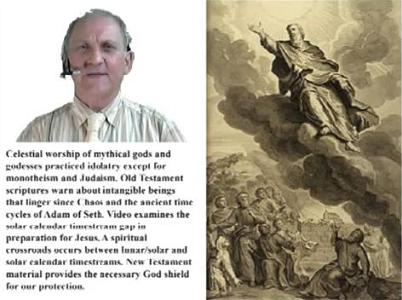 Mysterious
beings connected with the underworld are often described as good
or bad. Character deities can be angels that behave with
benevolence or demons with malicious intent. Mythical gods and
goddesses mainly derive from celestial worship. Idolatry was
common for anyone living outside monotheistic Judaism. Ancient
time cycles of the night sky were assigned to gods with a theme
promoting abilities to influence future events. Intangibles are
summoned through ritualistic behavior to invoke desires of the
occultist. All the warnings in the Old Testament are
appropriate when one reveals time enigmas this far back in remote
history. Fear and humility help us to avoid His wrath. The
Almighty is a jealous God indeed.
Mysterious
beings connected with the underworld are often described as good
or bad. Character deities can be angels that behave with
benevolence or demons with malicious intent. Mythical gods and
goddesses mainly derive from celestial worship. Idolatry was
common for anyone living outside monotheistic Judaism. Ancient
time cycles of the night sky were assigned to gods with a theme
promoting abilities to influence future events. Intangibles are
summoned through ritualistic behavior to invoke desires of the
occultist. All the warnings in the Old Testament are
appropriate when one reveals time enigmas this far back in remote
history. Fear and humility help us to avoid His wrath. The
Almighty is a jealous God indeed.
Exploring Adam and Seth as calendar elements
draws upon early, raw time. A primordial state of matter existed
before Heaven and Earth were divided. Elements of pre-Creation
lingered until weeks and calendars were defined. Our study of Seth
requires a certain level of personal protection. Seth's
primary and secondary age analysis encompasses far more than
stagnant calendar numbers. Uncontrollable spiritual inclinations
can be exposed from the darker side. Invisible things can attach
adversely. Light always follows, giving us reason to rejoice. A
preface from some New Testament material creates the
necessary God shield. We must pray to Jesus for
shelter from the storm. As He is increased, I am decreased.
wrrcr1pc150yc_1pc75b.jpg HTU Gn 5 Ages 4b.mp3 voiceover
1:22
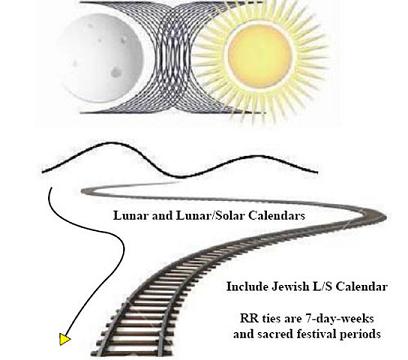 A yellow
arrowhead shows the lunar/solar calendar time stream. The Jewish
Calendar is the most prominent example existing today.
Intercalations were added to lunar-years by various methods to
synchronize, or catch-up the lunar-side with the solar-side.
Chronologists call them bound solar years that are shown here with
railroad ties. Ties between lunar and solar sides include 7-day-weeks
and important festival periods deemed sacred. Contemporary
Judaism observes according to the lunar/solar 19-year Metonic
cycle which became stabilized by Hillel II in 359 CE. A
curvy arrow indicates external social and political factors
affecting how lunar/solar calendars were used throughout history.
A yellow
arrowhead shows the lunar/solar calendar time stream. The Jewish
Calendar is the most prominent example existing today.
Intercalations were added to lunar-years by various methods to
synchronize, or catch-up the lunar-side with the solar-side.
Chronologists call them bound solar years that are shown here with
railroad ties. Ties between lunar and solar sides include 7-day-weeks
and important festival periods deemed sacred. Contemporary
Judaism observes according to the lunar/solar 19-year Metonic
cycle which became stabilized by Hillel II in 359 CE. A
curvy arrow indicates external social and political factors
affecting how lunar/solar calendars were used throughout history.
Jewish Passover references from the Gospels (Matthew
26:17-30; Mark 14:12-25; Luke 22:7-20) had always indicated
springtime and generally the lunar/solar calendar was used for
dating early Christian Easter. Roman expansion began
introducing the Julian solar calendar after 45 BCE and continued
through the Gospel era.
wrrcr1apc150_1pc63b.jpg HTU Gn 5 Ages 4c.mp3
voiceover 1:16 add 1 rr and follow with 2
and 3 rr tracks showing.
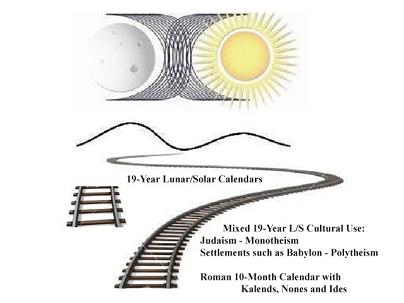
Different forms of lunar/solar calendars marked events prior to 45
BCE and the Roman Julian solar calendar switch. Settlements were
employing some form of 19-year lunar/solar system with
mixed opinion concerning spiritual allegiance. Some adhered to
Judaism, while others shared in polytheism. Baal and Asteroth were
prevalent in scripture surrounding the Babylonian Exile. Jewish
Calendar months today show legacy roots with nearby culture.
The early Roman calendar went through a myriad of successive
changes, from lunar to lunar/solar culminating with 10-months.
Attempts were made to transform moon phase names: Kalends,
Nones or Ides to the standardized pattern we know as new,
first quarter and full. February was the chosen month to add
intercalary days. Geo-political maneuvers further compounded any
adjustments. By the reign of Julius Caesar, the Roman calendar was
hopelessly confusing.
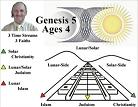
|
Understand_Genesis_5_Ages_4
Video & Script is from the fourth video in
the series, based upon works at timeemits.com website.
Videos and scripts are available resource sets. Ages_of_Adam
determines Antediluvian Patriarch ages and
background history as written in Genesis 5. Video
4: Jesus & Solar Time Stream tells about BCE
to AD calendar transition.
Cart Item Gn5A4VT includes Video 4
download .mp4, 29 mb and this transcript PDF download
590 kb
from Paypal-Payloadz for Only $ 1.98
|
V-29 mb
T-590 kb
1.98
|
wrrcr1bpc150_1pc62b.jpg HTU Gn 5 Ages 4d.mp3
voiceover 1:28 add 2 rr
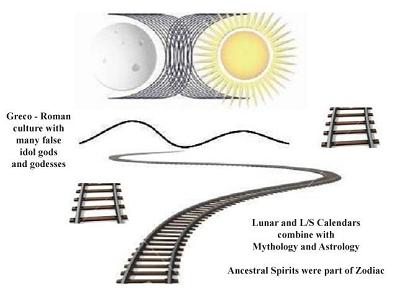 Greco-Roman
culture is replete with an entire pantheon of gods and goddesses.
Most other ancient cultures employed lunar/solar calendars, and
they too reflect mythology and astrology. Ancestral spirits
were once thought to ascend to heaven and join the stars. Egyptian
and Babylonian zodiacs are forerunners of modern star divination.
Brighter stars and wandering planets were more powerful and hence
collected spirits to achieve deity status.
Greco-Roman
culture is replete with an entire pantheon of gods and goddesses.
Most other ancient cultures employed lunar/solar calendars, and
they too reflect mythology and astrology. Ancestral spirits
were once thought to ascend to heaven and join the stars. Egyptian
and Babylonian zodiacs are forerunners of modern star divination.
Brighter stars and wandering planets were more powerful and hence
collected spirits to achieve deity status.
Nomadic tribes and smaller villages living outside of Egyptian
influence depended primarily upon lunar calendars. Stable
populations adopted lunar/solar versions for consistency over
longer periods. Months may have bore the same name for adjacent
groups. Starting days or weekly patterns varied with sighting
lunar crescents. Gods and goddesses were regional or
localized, so orphan calendars naturally proliferated. Trade and
governmental functions suffered due to dissimilar calendars. From
Africa to the Mediterranean coastline, sooner or later these
groups were destined to encounter the Roman Empire.
wrrcr1cpc150_1pc60b.jpg HTU Gn 5 Ages 4e.mp3 voiceover
1:40 add 3 rr
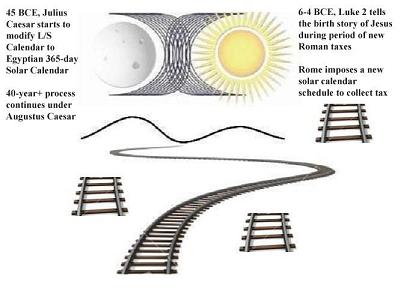 About 45
BCE, Julius Caesar modified the somewhat undefined Roman
lunar/solar calendar using the well established Egyptian
365-day solar calendar. Multiple lunar and lunar/solar
systems needed to be replaced for Rome to effectively dominate the
area. Nearly 40-years later, the Julian system was
expanding throughout Holy Lands and elsewhere. First emperor and
successor to Julius, Augustus Caesar chose to
rename the month following July after himself.
About 45
BCE, Julius Caesar modified the somewhat undefined Roman
lunar/solar calendar using the well established Egyptian
365-day solar calendar. Multiple lunar and lunar/solar
systems needed to be replaced for Rome to effectively dominate the
area. Nearly 40-years later, the Julian system was
expanding throughout Holy Lands and elsewhere. First emperor and
successor to Julius, Augustus Caesar chose to
rename the month following July after himself.
By 6-4 BCE, relative Gregorian chronology signals the Immaculate
Conception and Birth of the Savior. Luke 2 tells how new
Roman taxes were imposed. Rome's new solar calendar schedule was a
forced play. Time was in a state of flux and volatile during
preparation for Jesus. Egyptian and Roman solar-side
calendars were separated by the entrenched solar calendar
disruption. Jewish Calendar lunar/solar observance then placed
special emphasis upon the fledgeling Christian movement. A path of
important transition is apparent in the Four Gospels. God's
power was effectively purified for non-Jewish Gentiles. New
Testament literature serves to append earlier Covenants
and more broadly welcomes others to righteousness.
wrrcr1pc150g_1pc63b.jpg HTU Gn 5 Ages 4f.mp3
voiceover 1:27 gap picture
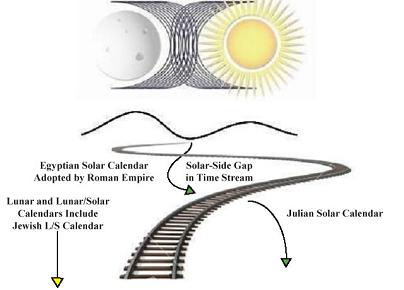 You may
already know the story of Mark Antony and Cleopatra as a royal
soap opera and effort to link two governments. No unified calendar
system existed before Julius Caesar came to power. The first
green arrowhead represents the Egyptian Calendar
that points to the solar-side gap in the time stream. Rome began
to implement the Julian solar calendar according to
regional control. The Son of God was born on the other
side of the 40-year solar calendar gap. A second green
arrow continues the Julian solar calendar during its
stabilizing process under Augustus Caesar.
You may
already know the story of Mark Antony and Cleopatra as a royal
soap opera and effort to link two governments. No unified calendar
system existed before Julius Caesar came to power. The first
green arrowhead represents the Egyptian Calendar
that points to the solar-side gap in the time stream. Rome began
to implement the Julian solar calendar according to
regional control. The Son of God was born on the other
side of the 40-year solar calendar gap. A second green
arrow continues the Julian solar calendar during its
stabilizing process under Augustus Caesar.
The life of Jesus Christ manifests a spiritual calendar
intersection. The solar-side time stream gap extends from about 45
BCE. World history reckoning changes from the steady Egyptian
Calendar to the new Julian Calendar. The Jewish
lunar/solar calendar railroad track solidly progresses through the
solar calendar opening. A co-eternal WOW moment was
happening. Jesus performed miracles by healing the lame
and restoring sight to the blind.
wrrcr1pc150star70pcb.jpg.jpg HTU Gn 5 Ages 4g.mp3
voiceover 1:52 WOW star
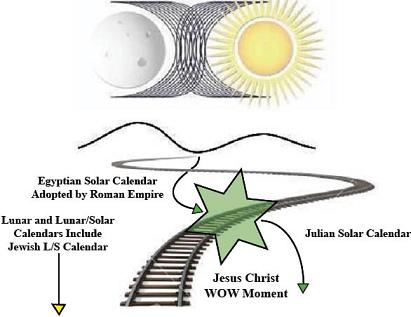 Christ
grew to be Savior during a highly unstable calendar. The Holy
Trinity involving God the Father, Son and Holy Spirit
was manifest during the calendar transition. Gaps, seams and
separations in the time stream are preconditions for supernatural
intercession. A green six pointed WOW star marks solar
time stream placement for Jesus. God authorizes prophecies
be fulfilled through His will. Miraculous deeds were
accomplished and scriptures written to record evidence. *Signs
and Wonders* in the divine realm verify His
presence. Ordinary physical boundaries of time and space were
overcome. New Testament events and early Christianity
exhibit reason for worship. Crucifixion and the Resurrection prove
the Son of God.
Christ
grew to be Savior during a highly unstable calendar. The Holy
Trinity involving God the Father, Son and Holy Spirit
was manifest during the calendar transition. Gaps, seams and
separations in the time stream are preconditions for supernatural
intercession. A green six pointed WOW star marks solar
time stream placement for Jesus. God authorizes prophecies
be fulfilled through His will. Miraculous deeds were
accomplished and scriptures written to record evidence. *Signs
and Wonders* in the divine realm verify His
presence. Ordinary physical boundaries of time and space were
overcome. New Testament events and early Christianity
exhibit reason for worship. Crucifixion and the Resurrection prove
the Son of God.
Geography and communications
hampered broad acknowledgment of the Julian calendar.
The Roman Empire applied the Julian calendar
within ambiguous borders. Following Paul's ministry in Acts until 70 AD, the early
church developed locally. Christ's supernatural powers persist
coincidental with acceptance. The Roman Empire includes
other calendars aligned with Augustan reforms. By the fourth and
fifth centuries AD, Alexandrian Christians, Coptic and Ethiopian
churches all observed Easter. Movement toward
associating Bible events with annual ceremony arose.
wrrcr1pc150cross_1pc63b.jpg HTU Gn 5 Ages 4h.mp3
voiceover 2:07 added cross
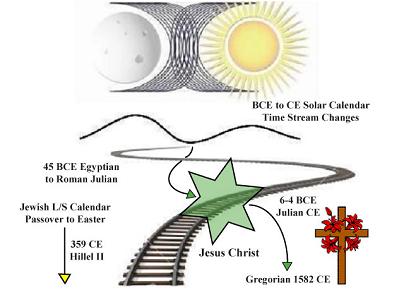
Juxtaposition of two very different calendars had consequences.
Presenting a universally recognized Roman solar calendar was
problematic to expansion. Passover was a movable Jewish
festival that Roman solar calendar adherents tried to fixate for Easter
purpose. Emperor Constantine arranged for official Easter
recognition while seeking personal salvation. Constantine and the
First Council of Nicaea established rules for solar Easter
celebration in 325 AD. Easter was defined as the first
Sunday after the full moon following the northern hemisphere's
spring equinox.
Roman solar calendar progression had a spillover effect. In
the fourth century, Hillel II felt Roman governance
pressure to establish a fixed calendar based on mathematical and
astronomical calculations. Since 359 CE and still in use,
the Jewish Calendar standardizes the lengths of months
and Adar intercalary months over the course of a 19-year
lunar/solar cycle. The lunar calendar synchronizes with
solar years based upon the Greek Metonic cycle. Taxes
could now be extracted ostensibly with the same frequency
throughout the Roman Empire. Our yellow arrow highlights
the Jewish lunar/solar calendar through several historical
phases. Realize prior to the Julian solar calendar
adoption, absolute chronology recorded time according to some
lunar/solar calendar variation. The life of Jesus and
accompanying Roman solar calendar served to append
the Western, Christian era onto spiritual Judaism.

|
Get
Related Articles:
Jesus_and_BC_to_AD_Calendars
includes two articles: Jesus
and BC Calendars and Jesus and AD Calendars in a single pdf file.
Roman calendar order in the late Before Christian Era (BCE)
represents a fluid period of history. Julius Caesar improved
a lunar calendar with random intercalations by adopting the
Egyptian solar calendar. Decisions that provide Before
Christ calendar dating versus our modern Anno Domini (AD or
CE, Common Era) epoch shape present history.
Cart Item JBCADC |

139 kb
0.99
|
tags history; Bible; ancient;
Antediluvian; Patriarchs; supernatural; lunar; solar; calendar;
spirituality; numbers; time
Clark Nelson is webmaster for http://timeemits.com/Get_More_Time.htm,
author of Ages_of_Adam
and sequel, Holy_of_Holies.
Revised Copyright 2014
Clark Nelson and timeemits.com All Rights Reserved.URL http://timeemits.com/Scripts/HTU_Gn_5_Ages_4_Script.html
 How to
Understand Genesis 5 Ages number 4 fast forwards from
ancient Genesis 5 Ages of Adam and Seth to introduce
spiritual concepts associated with calendar science. The emergence
of three time streams: lunar, lunar/solar and solar from
very early recording touches elements of Chaos that still exist. Holy
Bible time becomes organized through the Creative Week,
immediately followed by lengthy Genesis 5 Ages of the
Patriarchs. God is spirit, and His manifest powers
align with spiritual priority. Hidden influences, long thought
dormant, might awaken with candid resilience after many thousands
of years. This video examines the most important calendar gap in
history and how the Son of God appears as intercessor for
Christians.
How to
Understand Genesis 5 Ages number 4 fast forwards from
ancient Genesis 5 Ages of Adam and Seth to introduce
spiritual concepts associated with calendar science. The emergence
of three time streams: lunar, lunar/solar and solar from
very early recording touches elements of Chaos that still exist. Holy
Bible time becomes organized through the Creative Week,
immediately followed by lengthy Genesis 5 Ages of the
Patriarchs. God is spirit, and His manifest powers
align with spiritual priority. Hidden influences, long thought
dormant, might awaken with candid resilience after many thousands
of years. This video examines the most important calendar gap in
history and how the Son of God appears as intercessor for
Christians. Mysterious
beings connected with the underworld are often described as good
or bad. Character deities can be angels that behave with
benevolence or demons with malicious intent. Mythical gods and
goddesses mainly derive from celestial worship. Idolatry was
common for anyone living outside monotheistic Judaism. Ancient
time cycles of the night sky were assigned to gods with a theme
promoting abilities to influence future events. Intangibles are
summoned through ritualistic behavior to invoke desires of the
occultist. All the warnings in the Old Testament are
appropriate when one reveals time enigmas this far back in remote
history. Fear and humility help us to avoid His wrath. The
Almighty is a jealous God indeed.
Mysterious
beings connected with the underworld are often described as good
or bad. Character deities can be angels that behave with
benevolence or demons with malicious intent. Mythical gods and
goddesses mainly derive from celestial worship. Idolatry was
common for anyone living outside monotheistic Judaism. Ancient
time cycles of the night sky were assigned to gods with a theme
promoting abilities to influence future events. Intangibles are
summoned through ritualistic behavior to invoke desires of the
occultist. All the warnings in the Old Testament are
appropriate when one reveals time enigmas this far back in remote
history. Fear and humility help us to avoid His wrath. The
Almighty is a jealous God indeed. A yellow
arrowhead shows the lunar/solar calendar time stream. The Jewish
Calendar is the most prominent example existing today.
Intercalations were added to lunar-years by various methods to
synchronize, or catch-up the lunar-side with the solar-side.
Chronologists call them bound solar years that are shown here with
railroad ties. Ties between lunar and solar sides include 7-day-weeks
and important festival periods deemed sacred. Contemporary
Judaism observes according to the lunar/solar 19-year Metonic
cycle which became stabilized by Hillel II in 359 CE. A
curvy arrow indicates external social and political factors
affecting how lunar/solar calendars were used throughout history.
A yellow
arrowhead shows the lunar/solar calendar time stream. The Jewish
Calendar is the most prominent example existing today.
Intercalations were added to lunar-years by various methods to
synchronize, or catch-up the lunar-side with the solar-side.
Chronologists call them bound solar years that are shown here with
railroad ties. Ties between lunar and solar sides include 7-day-weeks
and important festival periods deemed sacred. Contemporary
Judaism observes according to the lunar/solar 19-year Metonic
cycle which became stabilized by Hillel II in 359 CE. A
curvy arrow indicates external social and political factors
affecting how lunar/solar calendars were used throughout history.


 Greco-Roman
culture is replete with an entire pantheon of gods and goddesses.
Most other ancient cultures employed lunar/solar calendars, and
they too reflect mythology and astrology. Ancestral spirits
were once thought to ascend to heaven and join the stars. Egyptian
and Babylonian zodiacs are forerunners of modern star divination.
Brighter stars and wandering planets were more powerful and hence
collected spirits to achieve deity status.
Greco-Roman
culture is replete with an entire pantheon of gods and goddesses.
Most other ancient cultures employed lunar/solar calendars, and
they too reflect mythology and astrology. Ancestral spirits
were once thought to ascend to heaven and join the stars. Egyptian
and Babylonian zodiacs are forerunners of modern star divination.
Brighter stars and wandering planets were more powerful and hence
collected spirits to achieve deity status. About 45
BCE, Julius Caesar modified the somewhat undefined Roman
lunar/solar calendar using the well established Egyptian
365-day solar calendar. Multiple lunar and lunar/solar
systems needed to be replaced for Rome to effectively dominate the
area. Nearly 40-years later, the Julian system was
expanding throughout Holy Lands and elsewhere. First emperor and
successor to Julius, Augustus Caesar chose to
rename the month following July after himself.
About 45
BCE, Julius Caesar modified the somewhat undefined Roman
lunar/solar calendar using the well established Egyptian
365-day solar calendar. Multiple lunar and lunar/solar
systems needed to be replaced for Rome to effectively dominate the
area. Nearly 40-years later, the Julian system was
expanding throughout Holy Lands and elsewhere. First emperor and
successor to Julius, Augustus Caesar chose to
rename the month following July after himself. You may
already know the story of Mark Antony and Cleopatra as a royal
soap opera and effort to link two governments. No unified calendar
system existed before Julius Caesar came to power. The first
green arrowhead represents the Egyptian Calendar
that points to the solar-side gap in the time stream. Rome began
to implement the Julian solar calendar according to
regional control. The Son of God was born on the other
side of the 40-year solar calendar gap. A second green
arrow continues the Julian solar calendar during its
stabilizing process under Augustus Caesar.
You may
already know the story of Mark Antony and Cleopatra as a royal
soap opera and effort to link two governments. No unified calendar
system existed before Julius Caesar came to power. The first
green arrowhead represents the Egyptian Calendar
that points to the solar-side gap in the time stream. Rome began
to implement the Julian solar calendar according to
regional control. The Son of God was born on the other
side of the 40-year solar calendar gap. A second green
arrow continues the Julian solar calendar during its
stabilizing process under Augustus Caesar.  Christ
grew to be Savior during a highly unstable calendar. The Holy
Trinity involving God the Father, Son and Holy Spirit
was manifest during the calendar transition. Gaps, seams and
separations in the time stream are preconditions for supernatural
intercession. A green six pointed WOW star marks solar
time stream placement for Jesus. God authorizes prophecies
be fulfilled through His will. Miraculous deeds were
accomplished and scriptures written to record evidence. *Signs
and Wonders* in the divine realm verify His
presence. Ordinary physical boundaries of time and space were
overcome. New Testament events and early Christianity
exhibit reason for worship. Crucifixion and the Resurrection prove
the Son of God.
Christ
grew to be Savior during a highly unstable calendar. The Holy
Trinity involving God the Father, Son and Holy Spirit
was manifest during the calendar transition. Gaps, seams and
separations in the time stream are preconditions for supernatural
intercession. A green six pointed WOW star marks solar
time stream placement for Jesus. God authorizes prophecies
be fulfilled through His will. Miraculous deeds were
accomplished and scriptures written to record evidence. *Signs
and Wonders* in the divine realm verify His
presence. Ordinary physical boundaries of time and space were
overcome. New Testament events and early Christianity
exhibit reason for worship. Crucifixion and the Resurrection prove
the Son of God.

